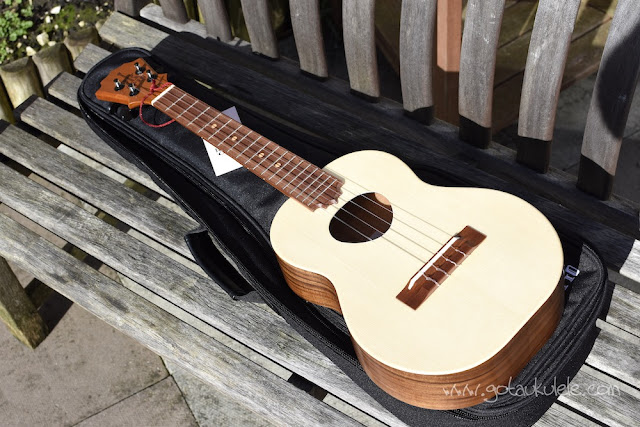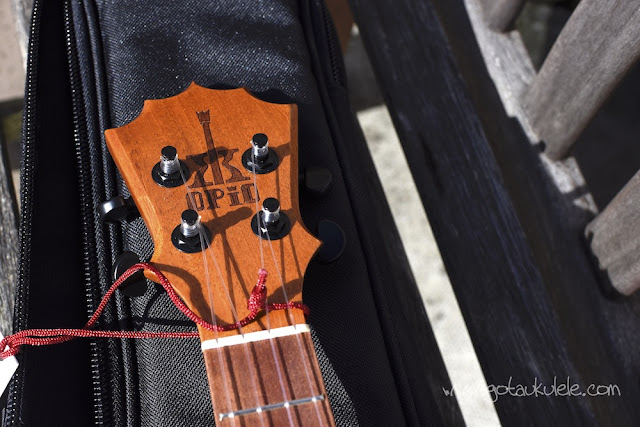It's been some time since I featured the KoAloha brand on Got A Ukulele, so I am delighted to do so again, this time with their spruce topped Opio series tenor uke.
Yet aside from the small wording on the makers label indicating the Thailand provenance, absolutely everything else on the instrument is pure KoAloha. Generally speaking it's a traditonal double bout shaped tenor, but very much a KoAloha shape. We have a wider lower bout, narrower upper bout and a flatter base than most, and of course that trademark KoAloha shaped soundhole. They call the soundhole design the 'musubi'. I have no idea if it is intended to make any sonic difference, but you have to admit that it looks mighty cool.
The top on this one is made from two pieces of solid spruce with all solid acacia back and sides. The sides and back are also in two pieces each and the back is dead flat. It's impeccably put together and finished in a satin coat and just screams quality when you pick it up. Whilst it's not edge bound, there is enough other interest in the design on these I think that mean it doesn't need it. The contrast between the two woods is beautiful I think, though I understand that people who are not a fan of pale top woods may look elsewhere. For me, I'm not such a fan of spruce, and dare I say it, I think it looks a little artificial to my eyes. I'd much rather a darker top with a distinct wood grain myself.
Bridge wise, this is a tie bar style made from mahogany and shaped to hold the TUSQ saddle with tapered ends. It looks nice, but I wonder if a darker wood would contrast better with that pale top. Another purely personal gripe. I would also say, I kind of miss the older KoAloha bridges that had the name carved into them.
Looking inside and it's pleasing to see that some more KoAloha traits from their Hawaiian series follow though. It's tidy inside, but you will notice no edge kerfing where the back and top meet the sides. This isn't as necessary to hold the thing together due to a bracing design that Koaloha use in the form of a unibrace. Essentially, mid way down the instrument is a brace that runs all the way around the inside of the instrument holding the top, back and sides together. Imagine the ukulele in cross section and picture a square piece of wood with the centre punched out - that is essentially what is fitted inside. To my knowledge, only KoAloha brace this way and it is incredibly strong yet light. We do however have another strengthening brace futher down inside across the lower bout, plus some strengthening pieces around the inside edge of the sound hole. And yes, like Hawaiian KoAloha's, the construction date is stamped on the neck block. Other than that you have a makers label and, it must be said, some excess glue drips...
The neck itself is finished in satin, and made from mahogany in two pieces, with the only joint being in the heel. The heel itself is also typically KoAloha with a beautiful sweep and tapering on the heel cap. Topping the neck is a mahogany fingerboard, also edge bound with mahogany strips. It's an interesting fingerboard choice and naturally paler than a rosewood or ebony alternative but it's in great condition. We have large circular inlaid wooden position markers facing out at the 5th, 7th, 10th and 12th spaces and thankfully these are repeated on the side. We have 18 nickel silver frets in total with 15 to the body and they are all finished wonderfully. It's also nice to see the trademark KoAloha shaping to the end of the fingerboard where it extends over the body.
Beyond the TUSQ nut we have the standout KoAloha shaped headstock. I really do think this is the best headstock shape in the ukulele world and it immediately tells you what it is. Some call it a five pointed crown, which I guess it is, but as I recall the inspiration comes from the top leaves of a pineapple. Just wonderful. Stamped into this is the KoAloha logo and the 'Opio' name.
Set into this are black finish KoAloha branded sealed geared tuners with kidney shaped buttons. They are impeccable and I love how the flared headstock shape has them set on an angle.
Completing the deal is a KoAloha soft gig bag. It's nice quality, but I have to say at this sort of price I'd be wanting a hard case to be honest. The strings are clear fluorocarbon to KoAloha's recipe in low G tuning, and for all of that you are looking at a UK price of about £680. So it's not a cheap ukulele, but equally, not the most expenisve you will find by any stretch.
In the hands the instrument is far lighter than you would expect and feels wonderfully solid and reliable. There is something about the combination of looks and construction on this one that makes it a delight to hold and play. And yes, as you would imagine, it's nicely balanced. The setup on this review model is also pretty much perfect, so no gripes there either.
The first thing that strikes you is how resonant and punchy it is. This one certainly goes into that category I have used before of 'almost plays itself'. Even the slightest touch of the strings projects well. That isn't to say it's overpowering, it's just really lively and responsive.
Clarity across the strings is superb and you get a real harmonic chime and jangle when strummed. It's very bright, as you may expect from a spruce and acacia mix, yet I can see what the low G choice is doing in toning down the brightness, but I still think it would be interesting to experiment with some other re-entrant strings. Perhaps it would leave it too bright, I don't know. I am told the all acacia version is brighter still which surprises me.
With that lively sound and resonance of course comes massive sustain that is just wonderful for fingerpicking. In fact I would stick my neck out and say this is really a melodic finger pickers instrument more than one for heavy brash strumming. That to me is where it really shines as a quality ukulele. Every note is incredibly clear and in its place in the mix. You just know you have a higher end instrument in your hands by the harmonics between the strings. Sometimes I found it a little too forward, and perhaps 'echoey', and that is more evident when strumming. Perhaps 'echoey' is an awful word to use and it sounds like I am doing it a disservice. I really don't mean to, as it may be my less than brilliant technique more than anything else. I just didn't get as much joy out of strumming it as I did from picking. Don't get me wrong, this has an outstanding tone either way and I am looking for issues mainly because there are so few.
All in all i've found it incredibly hard to find much wrong with this one at all. It matters not where it came from to me, this is an outstanding instrument and one that I would dearly love to own. The pale wood choice is not really my cup of tea I guess, but that's purely personal and there is no arguing with the build quality. As for the price, I actually think it's incredibly good value for the quality you are getting and certainly right up there with instruments costing considerably more. Highly recommended.
Thanks to Southern Ukulele Store who are KoAloha stockists for the loan of this one
http://www.southernukulelestore.co.uk
http://www.koaloha.com
UKULELE PROS
Wonderful construction and quality control
Amazing resonance and response
Great clarity across the dynamic range
Excellent volume
Good price
UKULELE CONS
Looks of wood choices not to my tastes - purely personal
UKULELE SCORES
Looks - 8.5 out of 10
Fit and finish - 9.5 out of 10
Sound - 9 out of 10
Value for money - 9 out of 10
OVERALL UKULELE SCORE - 9 out of 10
UKULELE VIDEO REVIEW
© Barry Maz










It was very interesting that you found an uncarved bridge on this one - I collected a soprano version of exactly the same model from SUS this week, and mine has got the bridge carved with the Koaloha name - really nice! Dave Lee
ReplyDeleteMaybe it's only carved on the sopranos
ReplyDeleteMy Opio acacia concert has the carved bridge, FWIW. I'm wondering how different this spruce top tenor sounds from the all-koa tenor (which I have, and I'm not sure I hear much difference). B-Maz, do you have a sense of how different it is or isn't, in sound?
ReplyDeleteFrom memory Dave, the Koa models (Hawaiian) have a richer, more complex tone - but there's not a lot in it if I am honest.
ReplyDeleteAwesome review, thanks Baz! Love KoAlohas. If I had a dealer anywhere near me I'd have a soprano Opio already, but I can't bring myself to pay that kind of money without trying first!
ReplyDeleteGood job!
ReplyDeleteHi I bought a Koaloha Tenor Ukulele and I paid more than a 1000. The Ukulele showed glue inside. Is it normal that the Koaloha Ukulele have glue inside? Thanks
ReplyDeleteSometimes. Doesn't do any harm, just looks messy. It's usually the giveaway of a lazy build, but I would be less concerned with Koaloha
ReplyDeleteto Clinica Jiminez, cc B_Maz, I'm sorry to hear about your tenor being a bit poorly finished inside. Disappointing thing to discover - typically we don't look closely for this during the purchase, then discover it later. Have you raised it with your supplier? My solid acacia Opio tenor is only a few short weeks old and have just taken the flashlight to the innards. Happily it shows an impeccable level of finish. The absence of a kerfing strip a bit unnerving, but that 'bulkhead' type brace is impressive. All the blocks and bracing look to be solid acacia too. I actually got in touch with the Koaloha head office in Hawaii to ask about the 'Asian acacia'. Got a reply from the Vice President Sales and Marketing saying he couldn't help, but I appreciated them getting back (he also confirmed the Opio will happily accept wound strings). From my research the timber is from a sustainably managed introduced species also known as 'monkey pod'. Cheers!
ReplyDelete